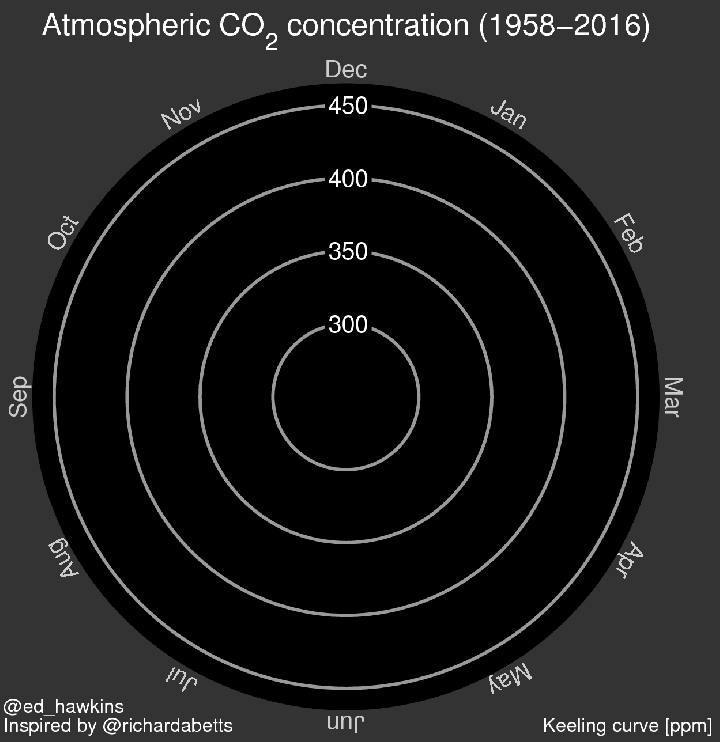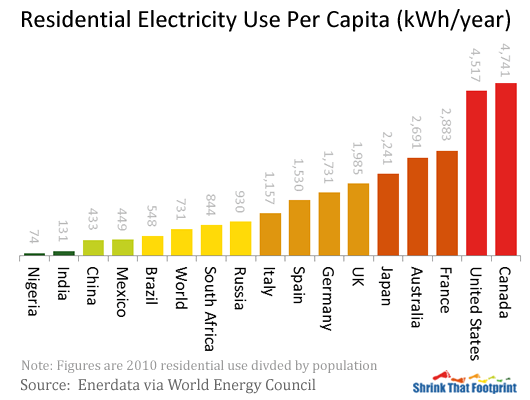So now that you’re washed and dressed, perhaps it’s time to put the kettle on. When purchasing (and reviewing) appliances it’s useful to know how much energy they consume: it may help you decide between different products and also give you an idea of whether energy efficiency is an important factor relative to other criteria. Since the incoming U.S. president claims to believe that climate change is a hoax, it’s worth reminding ourselves of how much the global temperature and atmospheric CO2 levels have risen in recent years (graphics by Ed Hawkins).


Even if you disagree with the overwhelming scientific consensus that man-made greenhouse gases (GHGs) cause climate change, you would still have to face the fact that energy generated from fossil fuels such as coal and natural gas is a major source of pollution and is not sustainable (i.e. the resources are not renewable and will run out).
Calculating GHG emissions: appliances
This may sound technical but it’s actually pretty easy, so bear with me! For appliances, electrical power consumption is measured in watts ( W ), and when you factor in the amount of time the appliance is in use, you end up with watt-hours (Wh). So if you turn on an 18 W bulb for two hours it’ll consume 36 Wh. When I compiled this, electricity in California cost around $0.15 per kWh (kWh = kilowatt hour = 1000 Wh), which is about average for worldwide prices (it’s now a little higher than that). So, let’s say you have five 18 W lightbulbs turned on for five hours per day for 340 days a year, that’s 5 x 18 x 5 x 340 = 153,000 Wh, or 153 kWh. At $0.15 per kWh, this will cost $0.15 x 153 = $22.95.
So you can stop there if you like – just knowing the energy used (kWh) or the cost ($) of this power is sufficient to compare energy use between your appliances. But it’s also easy to calculate the carbon footprint from the kWh number. On average in the U.S., the carbon cost is 0.7 kg of CO2 per kWh, so 153 kWh equates to: 153 x 0.7 = 107.1 kg CO2.
Typical energy use of domestic appliances
I’ve calculated energy consumption for a selection of appliances, assuming average power rating and moderate use (see table, below). You just need the power use (in watts) for your appliances, often found on the base of the appliance, on the box, or online. Then you just need to estimate the number of hours the appliance is in use. A few items (such as a fridge) are a little trickier in that they are on 24 h per day, but won’t consume power all the time (especially if you don’t open it often or stand staring into it!). For items that run on a rechargeable battery, the easiest way to estimate power usage is to look up the battery capacity (a cell phone will be around 10 Wh) and how many times you will charge that battery (perhaps daily for a phone), then the total power consumption is 10 * 365 = 3650 Wh, or 3.65 kWh. You can also look up typical numbers here which include default suggestions for typical usage.

How to reduce your carbon footprint at home
If you want to reduce your impact, you can see from the table above that you’ll make by far the most progress by focusing on reducing your use of things that heat and cool: water heating, air conditioning, home heating, fridge, and clothes dryer.
Some choices are obvious, such as an LED over plasma TV. Also, a desktop computer uses around 10 times more energy than a laptop (and also requires more energy to make) so a laptop is a better choice.
Energy use of a typical laptop or cell phone is very low, so if you are deliberating over a new purchase, energy efficiency is a small consideration and it makes more sense (in my opinion) to rate the items based on other factors such as raw materials, labor, corporate social responsibility, and product longevity.
Do appliances consume much energy on standby?
Most appliances made in the last 5 years don’t consume much energy in standby mode but if you have a cable box, TV, audio system, printer/scanner, or microwave that’s more than 5 years old, then these are the best things to focus on unplugging when not in use. The cable box is by far the biggest perp – in standby mode it uses more energy annually than lighting a typical apartment.
Game consoles use quite a bit of power – playing games uses the most power but video streaming comes close (on the PS4 and Xbox One) and so does the “active standby” mode (Xbox), used while watching TV. So, streaming video from a laptop or directly on a TV is a better choice than using a game console.
Change how you do your laundry!
Knowing the energy that goes into some tasks (e.g., washing and drying clothes) may also influence other consumer choices. For instance, a woolen sweater that is washed less often and typically air-dried may be a better choice than a cotton top, which is washed more frequently and typically dried in an electric dryer. Similarly, changing to a low temperature laundry detergent can save a lot of energy since heating water accounts for around one third of domestic energy use.
Total domestic electricity consumption
Here’s a chart from Shrink that Footprint, showing total annual residential energy use per person for a selection of countries.

Not surprisingly, electricity use in North America is very high. Those five 18 W light bulbs already consume more power (153 kWh) than the total electricity used by the average person in Nigeria or India. Since the average carbon footprint for electricity in the U.S. is 0.7 kg of CO2 per kWh, the average carbon footprint for residential electricity consumption (4517 kWh) is: 0.7 x 4517 = 3162 kg CO2 (= 3.16 tons CO2). For comparison, the average U.S. resident burns 480 gallons of gasoline in a year (that’s 12,000 miles in a 25 mpg car) generating 4272 kg (4.3 tons) of CO2. Adding in the carbon cost of natural gas used at home (2570 kg CO2 per California resident, according to PG&E) the annual carbon footprint of energy used at home and in a personal car adds up to around 10 tons CO2 per capita here in the Golden State, leaving a lot of room for improvement.
Green stars review – electric kettle
Back to that kettle: here’s an attempt to review the Breville Ikon electric kettle, based on social and environmental impact. It was a tricky item to review because the company, Breville, didn’t provide a lot of information on their operations. If I was to review it again today I’d probably be able to dig up more information about them, being a more seasoned Green Star reviewer now 🙂 But even considering the basics is also helpful: it’s designed so that it can boil a very small amount of water (less than one cup), thus reducing energy waste if you only want to make a cup of tea, and it was built to last a long time (and so it has – more than 10 years now). Please vote for the review if you find it helpful!

hope thats alright pressed this
LikeLiked by 1 person
Thank you – yes please feel free!
LikeLike
This is a fantastic post. Excellent work. Will be sure to share here in Ireland.
LikeLike
Thank you! Love your blog too 🙂
In Ireland the carbon cost of electricity is around 0.5 kg of CO2 per kWh, on average.
That’s the average. It’s a higher (around 0.6 kg of CO2 per kWh) for conventional electricity, and lower (around 0.4 kg of CO2 per kWh) if you buy electricity from Airtricity (a good proportion of which is wind-generated).
LikeLike
You’re a wealth of information 🙂
LikeLiked by 1 person
Haha – I try!
LikeLike
I would like to ask a question, even if I know the article is a bit old.
The article largely focuses on calculating the energy costs of running a household. This is, of course, quite important to the whole calculation, but I’m afraid it misses something: The energy costs of producing, rather than running, the appliances in the first place.
That latter information seems awfully hard to find, and Google’s distortion of all but the most basic, common searches is not helping, so I’m wondering if there’s a possibility you could direct me towards information that could help me see which manufacturers’ appliances are not only the most efficient in terms of energy use, but also efficiency of manufacture?
Probably a difficult task, so I’m not going to be too surprised if I can’t expect you to do it. I’d like to ask, anyway.
Thanks.
LikeLike
Hi Corspide,
With many of these things it’s hard to find a universal guide that is comprehensive in terms of product coverage and/or sustainability metrics. For example, Greenpeace’s guide to green electronics looks at a few metrics for major electronics brands, but that won’t help you if you want to buy a toaster 😉
https://www.greenpeace.org/usa/reports/greener-electronics-2017/
Similarly, this guide to the footprint of an electric car is useful but doesn’t consider all angles:
https://www.ucsusa.org/resources/cleaner-cars-cradle-grave
If there’s a particular kind of appliance that you’re trying to decide on, please let me know and I’ll try to help.
Thanks for your comment!
LikeLike
And thanks for your response.
I wasn’t referring to any particular appliance type, but general manufacturer information for future reference, whatever I buy, although I tend to consider computers/smartphones and large household appliances the most important for footprint. In either case, the links you have given are quite useful to me, so I’ll be keeping those handy. Thank you.
LikeLike
You’re very welcome. It’s one of the reasons why I believe we need user-generated ratings. It’s hard for a single organization to cover everything, but (as demonstrated by projects like Wikipedia) I believe user-generated content can get us there..
I’ll bear it in mind as a topic for future posts.
Cheers!
LikeLike